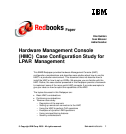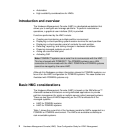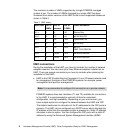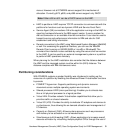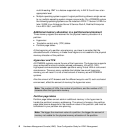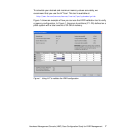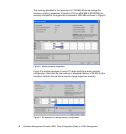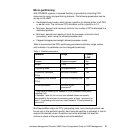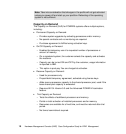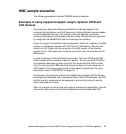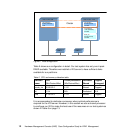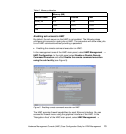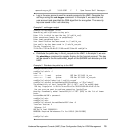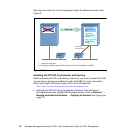
Hardware Management Console (HMC) Case Configuration Study for LPAR Management 5
menus. However not all POWER5 servers support this mechanism of
allocation. Currently p575, p590, and p595 servers support only DHCP.
HMC to partitions: HMC requires TCP/IP connection to communicate with the
partitions for functions such as dynamic LPAR and Service Focal Point.
Service Agent (SA) connections: SA is the application running on the HMC for
reporting hardware failures to the IBM support center. It uses a modem for
dial-out connection or an available Internet connection. It can also be used to
transmit service and performance information to IBM and also for CoD
enablement and billing information.
Remote connection to the HMC using Web-based System Manager (WebSM)
or ssh: For accessing the graphical interface, you can use the WebSM
Remote Client running on UNIX® (AIX® or Linux®) or Windows®. The
command line interface is also available by using the secure shell connection
to the HMC. It can be used by an external management system or a partition
to perform HMC operations remotely.
When planning for the HMC installation also consider that the distance between
the HMC and the managed system must be within 8m (26 ft) distance. The
distance complies with IBM maintenance rules.
Partitioning considerations
With POWER5 systems a greater flexibility was introduced in setting up the
resources of a partition by enabling the Advanced Power Virtualization functions
to provide:
POWER™ Hypervisor: Supports partitioning and dynamic resource
movement across multiple operating system environments.
Shared processor LPAR (micro-partitioning): Enables you to allocate less
than a full physical processor to a logical partition.
Virtual LAN: Provides network Virtualization capabilities that allow you to
prioritize traffic on shared networks.
Virtual I/O (VIO): Provides the ability to dedicate I/O adapters and devices to
a virtual server, thus allowing the on demand allocation and management of
I/O devices.
Capacity on Demand (CoD): Allows system resources such as processors
and memory to be activated on an as-needed basis.
Simultaneous multi-threading (SMT): Allows applications to increase overall
resource utilization by virtualizing multiple physical CPUs through the use of
Note: Either eth0 or eth1 can be a DHCP server on the HMC.



